by Eric Meier
When attempting to identify a wood sample, it’s important to keep in mind the limitations and obstacles that are present in our task. Before starting, please have a look at The Truth Behind Wood Identification to approach the task in a proper mindset; I consider the linked article to be required reading for all those visiting my site with the intent of identifying wood.
1. Confirm it is actually solid wood.
Before proceeding too much farther into the remaining steps, it’s first necessary to confirm that the material in question is actually a solid piece of wood, and not a man-made composite or piece of plastic made to imitate wood.
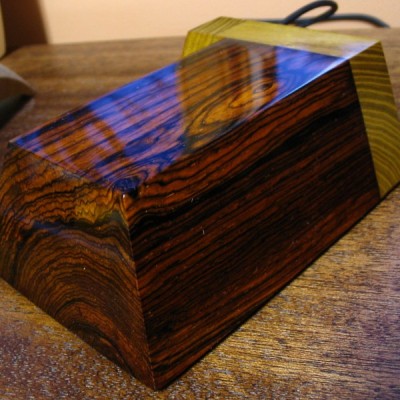
Can you see the end-grain?
Manufactured wood such as MDF, OSB, and particleboard all have a distinct look that is—in nearly all cases—easily distinguishable from the endgrain of real wood. Look for growth rings—formed by the yearly growth of a tree—which will be a dead-giveaway that the wood sample in question is a solid, genuine chunk of wood taken from a tree.
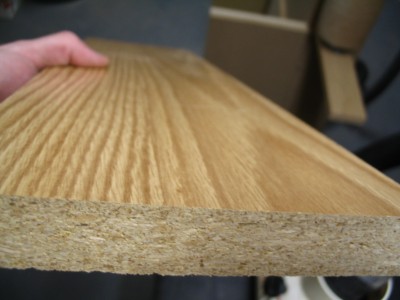
Is it veneered?
If you see a large panel that has a repeating grain pattern, it may be a veneer. In such cases, a very thin layer of real wood is peeled from a tree and attached to a substrate; sometimes the veneer can be one continuous repeating piece because it is rotary-sliced to shave off the veneer layer as the tree trunk is spun by machines. Assuming it is a real wood veneer with a distinct grain and texture—and not merely a piece of printed plastic—you may still be able to identify the outer veneer wood in question, but you should still realize that is it only a veneer and not a solid piece of wood.
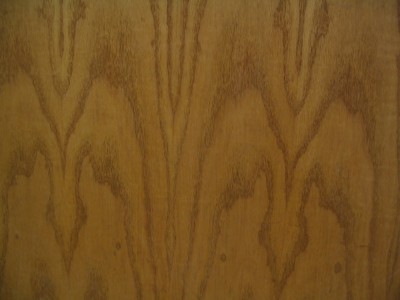
Is it painted or printed to look like wood?
Many times, especially on medium to large-sized flat panels for furniture, a piece of particleboard or MDF is either laminated with a piece of wood-colored plastic, or simply painted to look like wood grain. Many of today’s interior hardwood flooring planks are good examples of these pseudo-wood products: they are essentially a man-made material made of sawdust, glues, resins, and durable plastics.
2. Look at the color.
Some questions to immediately ask yourself:
Is the color of the wood natural, or is it stained?
If there is even a chance that the color isn’t natural, the odds are increased that the entire effort of identifying the wood will be in vain.
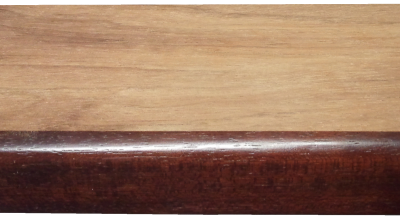
Is it weathered or have a patina?
Many woods, when left outside in the elements, tend to turn a bland gray color. Also, even interior wood also takes on a patina as it ages: some woods get darker, or redder, and some even get lighter or lose their color; but for the most part, wood tends to darken with age.
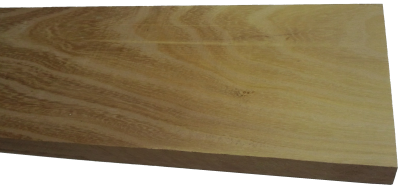
Is it possible to sand or plane the board to see the natural raw color of the wood?
The most predictable baseline to use when identifying wood is in a freshly sanded state. This eliminates the chances of a stain or natural aging skewing the color diagnosis of the wood.
3. Observe the wood grain.
If the wood is unfinished, then look at the texture of the grain. Ask yourself these questions:
Does the wood have an open, porous texture?
Most softwoods will be almost perfectly smooth with no grain indentations, while many common hardwoods have an open pore structure, such as oak or mahogany; though there are some hardwoods that are also smooth to the touch, such as maple.
Can you tell if the wood is quartersawn or plainsawn?
By observing the grain patterns, many times you can tell how the board was cut from the tree. Some wood species have dramatically different grain patterns from plainsawn to quartersawn surfaces. For instance, on their quartersawn surfaces, lacewood has large lace patterns, oak has flecks, and maple has the characteristic “butcher block” appearance.
Is there any figure or unusual characteristics, such as sapwood, curly or wild grain, burl/knots, etc.?
Some species of wood have figure that is much more common than in other species: for example, curly figure is fairly common in soft maple, and the curls are usually well-pronounced and close together. Yet when birch or cherry has a curly grain, it is more often much less pronounced, and the curls are spaced farther apart.
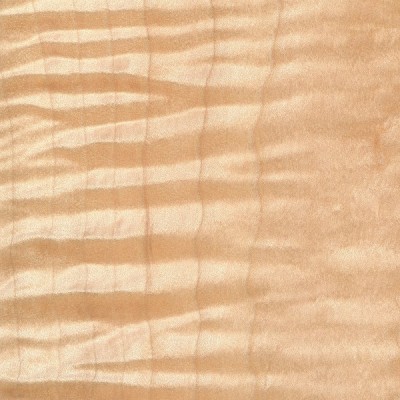
4. Consider the weight and hardness of the wood.
If it’s possible, pick the piece of wood up and get a sense of its weight, and compare it to other known wood species. Try gouging the edge with your fingernail to get a sense of its hardness. If you have a scale, you can take measurements of the length, width, and thickness of the wood, and combine them to find the density of the wood. This can be helpful to compare to other density readings found in the database. When examining the wood in question, compare it to other known wood species, and ask yourself these questions:
Is the wood dry?
Wood from freshly felled trees, or wood that has been stored in an extremely humid environment will have very high moisture contents. In some freshly sawn pieces, moisture could account for over half of the wood’s total weight! Likewise, wood that has been stored in extremely dry conditions of less than 25% relative humidity will most likely feel lighter than average.
How does the wood’s weight compare to other species?
Taking into account the size of the board, how does its weight compare to other benchmark woods? Is it heavier than oak? Is it lighter than pine? Look at the weight numbers for a few wood species that are close to yours, and get a ballpark estimate of its weight.
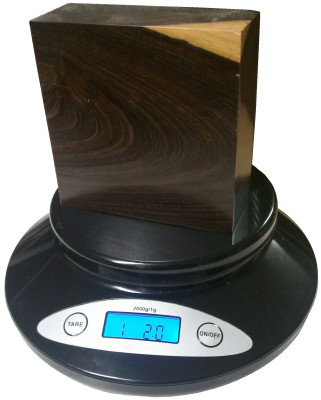
How hard is the wood?
Obviously softwoods will tend to be softer than hardwoods, but try to get a sense of how it compares to other known woods. Density and hardness are closely related, so if the wood is heavy, it will most likely be hard too. If the wood is a part of a finished item that you can’t adequately weigh, you might be able to test the hardness by gouging it in an inconspicuous area. Also, if it is used in a piece of furniture, such as a tabletop, a general idea of its hardness can be assessed by the number and depth of the gouges/dings in the piece given its age and use. A tabletop made of pine will have much deeper dents than a tabletop made of Oak. Additionally, you can always try the “fingernail test” as a rough hardness indicator: find a crisp edge of the wood, and with your fingernail try to push in as hard as you can and see if you’re able to make a dent in the wood.
5. Consider its history.
Many times we forget common sense and logic when attempting to identify wood. If you’ve got a piece of Amish furniture from Pennsylvania, chances are more likely that the wood will be made of something like black walnut or cherry, and not African wenge or jatoba. You might call it “wood profiling,” but sometimes it can pay to be a little prejudiced when it comes to wood identification. Some common-sense questions to ask yourself when trying to identify a piece of wood:
Where did it come from?
Knowing as much as you can about the source of the wood—even the smallest details—can be helpful. If the wood came from a wood pile or a lumber mill where all the pieces were from trees processed locally, then the potential species are immediately limited. If the wood came from a builder of antique furniture, or a boat-builder, or a trim carpenter: each of these occupations will tend to use certain species of woods much more often than others, making a logical guess much simpler.
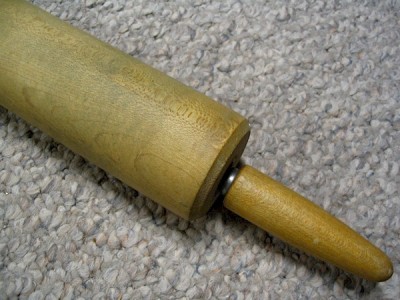
How old is it?
As with the wood’s source, its age will also help in identification purposes. Not only will it help to determine if the wood should have developed a natural patina, but it will also suggest certain species which were more prevalent at different times in history. For instance, many acoustic guitars made before the 1990s have featured Brazilian rosewood backs/sides, yet due to CITES restrictions placed upon that species, East Indian rosewood became a much more common species on newer guitars. (And this is a continuing shift as newer replacements are sought for rosewoods altogether.)
How large is the piece of wood?
Some species of trees are typically very small—some are even considered shrubs—while others get quite large. For instance, if you see a large panel or section of wood that’s entirely black, chances are it’s either painted, dyed, or stained: Gaboon ebony and related species are typically very small and very expensive.
What is the wood’s intended use?
Simply knowing what the wood was intended for—when considered in conjunction with where it came from and how old it is—can give you many clues to help identify it. In some applications, certain wood species are used much more frequently than others, so that you can make an educated guess as to the species of the wood based upon the application where it was used. For instance, in the United States: many older houses with solid hardwood floors have commonly used either red oak or hard maple; many antique furniture pieces have featured quartersawn white oak; many violins have spruce tops; many closet items used aromatic red cedar, and so forth. While it’s not a 100% guarantee, “profiling” the wood in question will help reduce the number of possible suspects, and aid in deducing the correct species.
6. Find the X-Factor.
Sometimes, after all the normal characteristics of a sample have been considered, the identity of the wood in question is still not apparent. In these instances—particularly in situations where a sample has been narrowed down to only a few possible remaining choices—it’s sometimes helpful to bring in specialized tests and other narrower means of identification.
The following techniques and recommendations don’t necessarily have a wide application in initially sorting out wood species and eliminating large swaths of wood species, but will most likely be of use only as a final step in special identification circumstances.
Odor
Believe it or not, freshly machined wood can have a very identifiable scent. When your eyes and hands can’t quite get a definitive answer, sometimes your nose can. Assuming there is no stain, finish, or preservative on or in the wood, quickly sand, saw, or otherwise machine a section of the wood in question, and take a whiff of the aroma.
Although new scents can be very difficult to express in words, many times the scent of an unknown wood may be similar to other known scents. For instance, rosewoods (Dalbergia spp.) are so named for their characteristic odor that is reminiscent of roses. Although difficult to directly communicate, with enough firsthand experience scents can become a memorable and powerful means of wood identification.
Fluorescence
While certain woods can appear basically identical to one another under normal lighting conditions, when exposed to certain wavelengths—such as those found in blacklights—the wood will absorb and emit light in a different (visible) wavelength. This phenomenon is known as fluorescence, and certain woods can be distinguished by the presence or absence of their fluorescent qualities. See the article Fluorescence: A Secret Weapon in Wood Identification for more information.
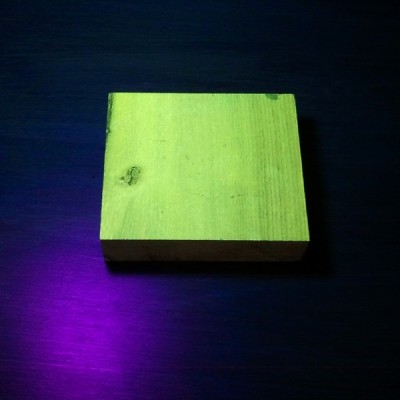
Chemical Testing
There are only a small number of chemical tests regularly used on wood, most of which are very specialized and were developed to help distinguish easily confused species with one another. They work by detecting differences in the composition of heartwood extractives. A chemical substance (called a reagent) is usually dissolved in water and applied to the wood surface: the surface is then observed for any type of chemical reaction (and accompanying color change) that may occur. Two of the most useful are the tests that are meant to separate Red and White Oak, and Red and Hard Maple.
Heartwood Extractives Leachability
Sometimes a wood species will have heartwood extractives that will be readily leachable in water and capable of conspicuously tinting a solution of water a specific color. For instance, the heartwood extractives contained in osage orange (Maclura pomifera) contain a yellowish-brown dye that is soluble in water. (This can sometimes be observed anecdotally when the wood is glued with a water-based adhesive: the glue’s squeeze-out is an unusually vibrant yellow.)
In a simple water extract color test, wood shavings are mixed with water in a vial, test tube, or other suitably small container, and the color of the water is observed after a few minutes. If the heartwood extractives are leachable by water, then a corresponding color change should quickly occur.
In addition to osage orange (Maclura pomifera), merbau (Intsia spp.), and rengas (Gluta spp. and Melanorrhoea spp.) are also noted for their readily leachable heartwood extractives. Because this property is quite uncommon, it can serve to quickly differentiate these woods from other lookalikes.
7. Look at the endgrain.
Perhaps no other technique for accurate identification of wood is as helpful and conclusive as the magnified examination of the endgrain. Frequently, it brings the identification process from a mostly intuitive, unscientific process into a predictable, repeatable, and reliable procedure.
Looking at the endgrain with a magnifier shouldn’t be a mystifying or esoteric art. In many cases, it’s nearly as simple as examining small newsprint under a magnifying glass. There are three components necessary to reap the full benefits contained in the endgrain:
I. A prepared surface.
When working with wood in most capacities, it becomes quickly apparent that endgrain surfaces are not nearly as cooperative or as easily worked as face grain surfaces. However, in this case, it is absolutely critical that a clear and refined endgrain surface is obtained.
For a quick glance of a softwood sample, a very sharp knife or razor blade can be used to take a fresh slice from the endgrain. However, in many denser species, especially in tropical hardwoods, one of the best ways to obtain a clear endgrain view is through diligent sanding. It’s usually best to begin with a relatively smooth saw cut (as from a fine-toothed miter saw blade) and proceed through the grits, starting at around 100, and working up to at least 220 or 320 grit, preferably higher for the cleanest view.
II. The right magnifier.
It need not be expensive, but whatever tool is used to view the endgrain should have adequate magnifying power. In most instances, 10x magnification is ideal, however, anything within the range of 8 to 15x magnification should be suitable for endgrain viewing. (Standard magnifying glasses are typically in the range of 2 to 4x magnification.)
These stronger magnifiers, sometimes called loupes, usually have a smaller viewing area than standard magnifying glasses. Fancier models—with built in lights, or larger viewing surfaces—are available at a premium; but the most basic models are usually only a few dollars.
III. A trained eye.
The third element that constitutes a proper endgrain examination is simply knowing what to look for. In analyzing the patterns, colors, shapes, and spacing of the various anatomical features, there is a veritable storehouse of information within the endgrain—all waiting to be unlocked. Yet, if these elements have not been pointed out and learned, the array of features will simply seem like an unintelligible jumble. The discipline of recognizing anatomical endgrain features is not easily summed up in a few sentences or even a few paragraphs, but it is nonetheless critical to the identification process. To this end, an in-depth look should be given to the various categories, divisions, and elements that constitute endgrain wood identification on the macroscopic level. (In this regard, macroscopic denotes what can be seen with a low-powered, 10x hand lens—without the aid of a microscope—rather than simply what can be seen with the naked eye.) Because the anatomy between softwoods and hardwoods is so divergent, each will be considered and examined separately:Still stumped?
If you have a mysterious piece of wood that you’d like identified, you’ve got a few options for next steps:USDA’s Forest Products Laboratory
You can mail your physical wood samples to the Center for Wood Anatomy Research.
Pros:
- Free
- Professional wood identification
Cons:
- Only available to US citizens
- Slow turnaround times (up to a month or more)
- Limited to three IDs per year
See their Wood ID Factsheet for more info.
Alden Identification Service
You can mail your physical wood samples (even small sections taken from antiques) to Alden Identification Service.
Pros:
- Professional wood identification
- Faster turnaround times (ranging from a few days to a week or two)
Cons:
- Paid service
See their ordering page for more info. (Note that Harry Alden has written several books while at USDA, including both Hardwoods and Softwoods of North America.)
Ask for help online
If the wood ID is merely a curiosity, or non-critical, you can post pictures of the wood in question.
Pros:
- Free
- No need to send physical samples
Cons:
- Greatly limited by the quality of the pictures provided
- Extra work usually required to get adequate clarity in photos
See article of Common US Hardwoods to help find the most commonly used woods.
Get the hard copy
 If you’re interested in getting all that makes The Wood Database unique distilled into a single, real-world resource, there’s the book that’s based on the website—the Amazon.com best-seller, WOOD! Identifying and Using Hundreds of Woods Worldwide. It contains many of the most popular articles found on this website, as well as hundreds of wood profiles—laid out with the same clarity and convenience of the website—packaged in a shop-friendly hardcover book.
If you’re interested in getting all that makes The Wood Database unique distilled into a single, real-world resource, there’s the book that’s based on the website—the Amazon.com best-seller, WOOD! Identifying and Using Hundreds of Woods Worldwide. It contains many of the most popular articles found on this website, as well as hundreds of wood profiles—laid out with the same clarity and convenience of the website—packaged in a shop-friendly hardcover book. 





Why I will no longer be replying to every wood ID request I’ve replied to literally thousands of wood ID requests on this site over the past 13+ years, but as the site’s popularity has grown, so has the time demands for ID on a daily basis. (Contrary to what some may seem to think, I am not some all-knowing wood wizard that can instantly ID your wood. It can actually take me a long time to sift through a lot of different resources.) Over the past few years, my backlog of pending wood species to be added to the… Read more »
Hello folks, any idea what kind of wood can be that?
Hello, could anyone identify the type of this wood please? :)
Looks like a softwood. More than likely something like Pine, Fir, etc. Pretty tough to ascertain the particular type of softwood without cutting into a piece and examining the endgrain for presence/absence of resin canals.
Looks like a ring-porous hardwood that’s been stained a darker color. My first thought was oak, but I don’t seen any ray fleck anywhere on the piece, so I’d suspect that it is ash.
Can anyone tell me what kind of wood this is?
Can anyone tell me what kind of wood this is its off a 1953 cabinet door
What kind of wood is this
I would like to identify the wood of the two garden furniture ( one table and one chair) and looking for which kind of lacquer or oil to protect them from the weather. Thanks!
how about this one?
[url [/img][/url][url=https://flic.kr/p/rp4dXy]20150411_122920[/url] by [url=https://www.flickr.com/people/128647662@N06/]laurencerexedwards[/url], on Flickr
[/img][/url][url=https://flic.kr/p/rp4dXy]20150411_122920[/url] by [url=https://www.flickr.com/people/128647662@N06/]laurencerexedwards[/url], on Flickr
This is set 2 – all are images of the same product from different distances to help make identification easier. Need your help in identifying the wood. Do let me know in case images are unclear or better images are required.
If I had to guess, based on those rays, I’d say Red Oak. But that’s just a guess. Do you have a clear, sanded, closeup shot of the endgrain?
There are two sets of wood pictures I’m posting. This is set 1 – all
are images of the same one from different distances to help make
identification easier. Need help to identify the wood.
Do let me know in case images are unclear or better images are required.
Can anyone tell me how much I could sell this desk for? It is 46″ X 74″ Claw Foot Lawyer desk, Needs refinished.
Can anyone id this pair? They are natural with the carving patterns as seen.
Well, it took me a while, but I think I figured out what in the world this is. I believe it is a tree fern, so technically not a “hardwood” or “softwood” or even a monocot, but something else entirely. https://en.wikipedia.org/wiki/Cyatheales
I have no idea what kind of wood this is! Help! Just split it today.
Looks to me like locust
Hi there, recently bought these pen blanks off a private seller, wondering if you could help ID these pieces for me? Thanks in advance!
Anyone know what kind of wood this is ? It is flooring that i have sanded down
Looks very much like Hard Maple. (I should know, as that’s exactly what the floors in my apartment are made of!)
Ok thanks ! Thats what i was told as well so thanks for the reassurance
Hi guys, Can somebody help me identify this wood?. I was told this is a malaysian hardwood but i want to know what kind. A client of mine is selling around 200pcs of this (8″x8″x8ft).this came from an old mine here in the philippines. I also want to know the value of this. :D thank you.
Too weathered and distant to make out any anatomical details on the endgrain.
Could anyone advise what wood you believe our Grandfather clock is made from please? Its allegedly quite an old boy! Ive tried to catch it in the best light I can
That front panel appears to be a crotch veneer. The two most common species for these sorts of veneers are walnut or mahogany. Judging by the border around it, it appears to be mahogany. Not sure of the rest of the clock though, but the front looks to be veneered.
Thank you very much
can any one give me any info on this what is it and what wood is it thanks
Looks fairly nondescript. Maybe maple or birch?
I received a proposal, from Africa, for woods called: “LIFAKI, BOSASA, BOLENGU, KAYA, LONGO, NGOLA, TOLA and SINGA-SINGA” do you have an idea of what is it?
Try looking the names up here:
https://www.prota4u.org/search.asp
(PROTA is one of the best resources for African woods, IME.)
Any guesses here? This is about 5 to 6 inches across, photoed from about 20 inches away. This is from a burl, so I’m not sure the pattern will tell a lot. The flat circular face was facing inward toward the heartwood. the side resting on the paper towel is a live edge.
That’s a real stumper. Where are you located? Did you find/cut this wood locally, or how did you come across it?
I’m in middle Tennessee, but this was purchased unlabeled in a St. Louis, MO hard woods store.
I’d consider the common native burl woods first: maple, elm, or oak. Scent might be an indicator too.
Thanks for the suggestions. I believe it to be a spalted maple after having Googled around a bit to find examples of the woods you mentioned. The smell while turning reminded me of walnuts, but the various walnut examples I found don’t match as closely as maple. I’m not sure what walnut wood smells like compared to it’s nuts, and I’m not even 100% sure it was walnut I was smelling. I could have been easily smelling maple and not known the difference.
The bark might help too, if it’s still on there.
I wouldn’t be so quick to say Maple just because it’s spalted. Maple is by far the most commonly sold wood that’s spalted, but just about any wood will exhibit spalting — especially the sapwood. Spalting is especially common on “found” woods that may not have been harvested/dried right away after the tree came down.
I think it is black walnut burl.
I try to find and buy this wood but don’t know the name and where to buy. Pls help
Can anyone help me figure out the type of wood this is, its my coffee table an i was sanding it an found it very light underneath all the stain and poly but dont know the kind of wood it is. Please help if u can.
A really good start is to know when it was made…
Can anyone help me figure out the type of wood this is, its my coffee table an i was sanding it an found it very light underneath all the stain and poly but dont know the kind of wood it is. Please help if u can.
Could anyone assist in identifying this wood? Thanks!
Nice pics.
Looks like pine. Probably a variety of Southern Yellow Pine, though it could be another type of hard pine. You might consider weighing the piece. Also check out this article:
https://www.wood-database.com/wood-articles/pine-wood-an-overall-guide/
Anyone have an idea about this one? From a roughly 100 year old dresser
Whatever it is, it looks NICE.
It looks like walnut to me: plain lumber for the structural parts, and burl veneer for the drawer fronts.
Can anyone id the wood of my didge? Not bunk bed lol
Help, looking to duplicate this gate. Any ideas on the type of wood in this project?
Regardless of the exact species of the wood used in the gate in the picture, I’d use cedar (types and colors will vary depending on your location).
For exterior projects, you’re much more limited to the woods you can use; plus, that thing would be very heavy if you used a denser wood.
Okay, I’m trying to find out what the wood paneling in our house is. I’m thinking maybe cherry. Any ideas?
Cherry is definitely what it looks like. Though it could be another wood (like Birch or Poplar) that was stained to look like Cherry.
Can anyone identify this wood? It has a different colour core to its outer skin, it is not polished and has not been died. Thanks
Are you sure that’s the natural wood color and that it hasn’t been charred or burned to alter the color? The sapwood looks very dark for sapwood, and of course the heartwood is nearly black. Most black woods like ebony will have an almost yellowish white sapwood.
Another gentleman suggested it was bangari, a type of Zimbabwean wood? There is no residue or polish that is visible on the carving. I will take a picture of the underneath of the carving tonight and post it as it may hold the key to its identity. I will make sure to bump up the quality on that pic. Thanks.
Thanks Darren, a pic of the bottom would be helpful. If you can, I’d try to thoroughly sand it to a very fine grit to get the clearest view possible. Also, a scientific name for “bangari” would be helpful — I don’t know which wood you are referring to.
Can anyone please tell me or give me a 2nd opinion on the kind of wood species this may be….
Can anyone please tell me or give me a 2nd opinion on the kind of wood species this may be…. I’m thinking it could be knotty pine wood.??
Eric, any chance you could help identifying the wood used for this wall paneling? It was removed during house remodel and we would like to recreate the look. My research indicates that it may be curly maple. Thanks a lot! Bart.
Yeah, the grain pattern definitely looks like curly maple. It looks to be expertly stained a nice reddish brown.
Thanks Eric. We will look for someone in Chicago area to replicate this. Great job on your website, really nice resource.
Bart
Anyone have any clue as to what type of wood this wonderful old rocker is? Or who may have made it?
Thanks in advance!
Looks like quilted maple to me, probably dyed/tinted a bit darker than its natural color.
The grain figure is called quilted, though on some woods like Sapele, it’s also called “pommele” or blistered. At first glance it looks more like Sapele, but when I look closer at the grain, it looks more like quilted maple that’s been colored to look reddish brown.
Birdseye Maple
Thanks so much for your reply! I was able to get underneath the side of
one of the end tables and get a shot of some bare wood – one with a flash, one without. I also included a
shot of the top of the headboard which has some interesting grains that
might help?Thanks again!! We’re eager to solve the mystery!
Well, whatever it is, I’m guessing you’ll have a hard time matching something like that! Truly gorgeous.
It could very well be a rosewood, though it may also be Pau Ferro, which is sometimes called Bolivian Rosewood, though technically not a true rosewood.
walnut
We inherited a beautiful solid wood bedroom set, but I’m not sure what type of wood it is. It does have some natural little pits in the wood. Can you help us identify it? We’d be SO appreciative :-) Thanks for your time!
Pretty hard to tell. Overall, I think the look they were trying to replicate with a nice aged Cherry. I’m inclined to think it’s not actually Cherry. At first I was thinking possibly maple or birch, but the knots on the draw fronts suggest a softwood.
I know it may not be possible, but a clear, sanded, closeup view of an endgrain surface would go a long way in IDing this wood.
Thank you so much! I took some pictures of the sanded, unstained wood underneath one of the end tables, as well as a good pick of the grain of the wood on the top of the headboard(still stained). I don’t think I can post them in the comment reply section, but I”ll post them in another discussion comment, if that’s alright. Thanks again for helping us solve the mystery!
Same here!(except for the camp part) :) I make manzantia vases, and bottles.
Does anyone know what wood this is!?
Does anyone know what this wood is?!
Does anyone know what this wood is?
That looks weird to me. Are you sure that isn’t plywood that you’ve partially sanded through the top layer? My guess is birch.
Sally, that is Ambrosia Maple. The holes and discoloration is from the Ambrosia Beatle.
Good eye; I hadn’t noticed those bug-holes on first glance.
Can you tell me what this cabinet door is made of
This is a door and frame,any ideas as to what it is?
Probably stained oak, though I can’t quite make out any rays, so it may very well be ash.
I look same to mine but I don’t know the name
Possibly maple? Too hard to tell from picture. Need a clear, sanded, zoomed-in shot of the endgrain.
Maple..
I tried to post this a few days ago, but my phone went all
cattywampus on me and I didnt get the right pics loaded…so one more time.
I took apart a beat up piano that was built in 1909-12 and got about 18ish bf of usable lumber that Im not sure about. face, quarter and end grain pics and some sawdust.
Thanks ejmeier for input on elm. Ill try to get closer pics when I get back home (found this out of town).
I might need to lower the res or something. None of the pics are loading for me, hopefully someone can see them..
On a side note, it took a few passes to clean these up. I have a new 60t blade on and tried to hog right through it and it was rough going. The cuts in the pics took about 5 passes raising the blade about ~1/2″ each pass.
after scrolling down it looks like my OP has all the pics now. So if a mod can either delete this thread or merge it with the last, however you want to do it. I hate to dirty up forums with re-posts. Sorry about that.
Can anyone tell me the kind of wood thst the table is made out of? Its a french table from the 1920s or so. Dark red brownish wood. Im thinking oak. Can anyone give an opinion?
Almost impossible to tell from picture. Oak is not known for being carved as it is quite ring-porous and not well suited to holding fine details.
Mahogany?
I found a an old 1912 Hobart Cable upright piano that was pretty well thrashed. I took it apart and saved some timbers and smaller blocks. The small pieces are a bright green poplar that will be neat for some turning. I’m having trouble identifying the timbers. I cleaned up a piece and hope someone can help identify this. I’ll post up face, quarter and end grains. Thanks in advance!
face and quarter grain
Photos wont upload, 2nd try
looks like elm to me.
I concur
Can anyone tell me what kind of wood this is please?
Can anyone tell me what wood this is plz.
Too hard to tell from the picture. Need some closeups of the grain…
Can someone please assist in identifying the below wood, it looks really nice when cleaned up and treated however it’s not protruding enough to leave exposed once i re-plaster the wall so i’d like to get something very similar and bolt it to the front
They are from a 1920s house in Ramsey, Cambridgeshire it’s quite hard stuff but unfortunately as it’s holding my roof up i can’t exactly see the end of the plank as advised in the guides on this site
in the process of restoring this table. ive sanded of all the damage its had from over the years. not sure what kind of wood it is though
Looks like a softwood. Possibly pine?
very generic grain = pine